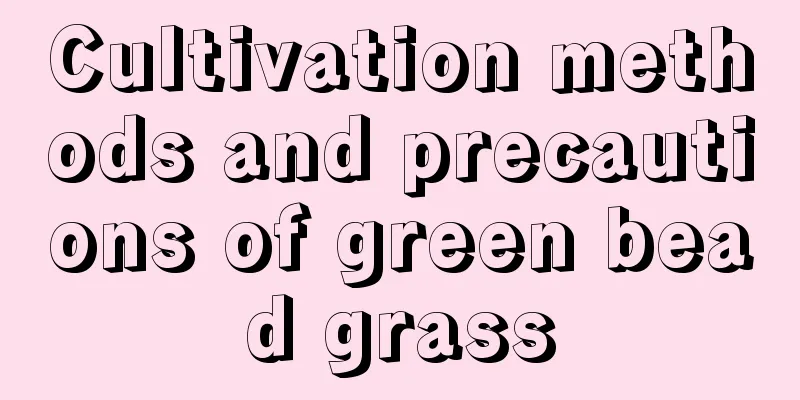Cultivation methods and precautions of green bead grass

1. Maintenance methods1. Light management: When green grass grows, it is different from other plants. Do not give the green bead grass enough sunlight, because it belongs to the Urticaceae family and is a plant that likes semi-shaded environment, so try to avoid direct sunlight when caring for it. 2. Water replenishment: Keep the soil moist all year round, moderately moist is fine. Because green pearl grass is a waterlogging-resistant plant with a well-developed root system, it can grow in swamp environments. 3. Nutrient management: Green pearl grass has a well-developed root system, so it has relatively high requirements for nutrients. It should be fertilized once a month, and nitrogen, phosphorus and potassium compound fertilizers can be used. 4. Temperature management: This plant is not winter-resistant and prefers a warmer environment. The temperature must be kept above ten degrees Celsius during the winter. 2. Breeding techniques1. Reproduction: Green pearl grass mainly reproduces asexually, and its stolons can grow rapidly in a suitable environment and spread throughout the area. Therefore, its reproductive ability is very strong, making it suitable for cultivation by modern young people and potted plant enthusiasts. 2. Repotting: Because of its well-developed root system, it is recommended to be potted in an environment with loose soil. When the space in the flowerpot becomes smaller, it should be repotted in time. 3. Problem diagnosis and treatment1. Yellowing leaves: Green grass mostly lives in a moist and semi-shaded environment, so the hot summer can easily cause the leaves to turn yellow. At this time, we should keep its growing environment moist and semi-shaded. 2. Death in winter: Because green grass is not winter-resistant, it is easy for the plant to die in the cold winter, so you must take anti-cold measures. IV. Other issues1. Is it poisonous? Green pearl grass is non-toxic, and its emerald green leaves are very ornamental and suitable for home cultivation. 2. Can it be planted in the ground: Due to its special habits, it can be planted in the ground or in potted plants. In addition, it can grow well with reasonable maintenance. |
<<: Cultivation methods and precautions of pineapple sage
>>: Marjoram cultivation methods and precautions
Recommend
How to repot a banyan bonsai
Banyan bonsai repotting time Generally speaking, ...
What flowers are suitable for growing in Meizhou? What are the city flowers and trees?
1. Climate characteristics of Meizhou Meizhou has...
Can potted peppers be watered with rice water (can fermented rice water be used to water peppers)
Rice washing water has limited nutrition and it i...
How to water cedar in winter
Watering cedar in winter Cedar needs watering in ...
Taboos on cultivating purse flowers in winter
Wind and Light The purse flower has very high req...
Are water pinellia and pinellia the same?
Different appearance Water Pinellia: There are 3 ...
What rootstock should be used for grafting osmanthus
1. Ligustrum lucidum Both Ligustrum lucidum and O...
How to propagate primroses by cuttings
1. Cutting time Because primrose is a perennial h...
How to care for the newly bought cat's eye arrowroot
1. How to deal with the newly bought cat's ey...
How to prune peacock ball
1. Withered and yellow leaves There are also smal...
How to cultivate Asparagus cochinchinensis
1. Soil It can grow well outdoors, so it has almo...
How to water strawberry seedlings?
Strawberry is a herbaceous plant, and improper wa...
The Language of Cherry Blossoms
1. Flower Language As we all know, cherry blossom...
These 4 kinds of "plants" are common and easy to grow. One leaf can be inserted into the soil and become a potted plant in 30 days.
Cuttings are a means of plant propagation. Throug...
When is the best time to plant carnations?
Carnations are perennial flowers that come in a v...









